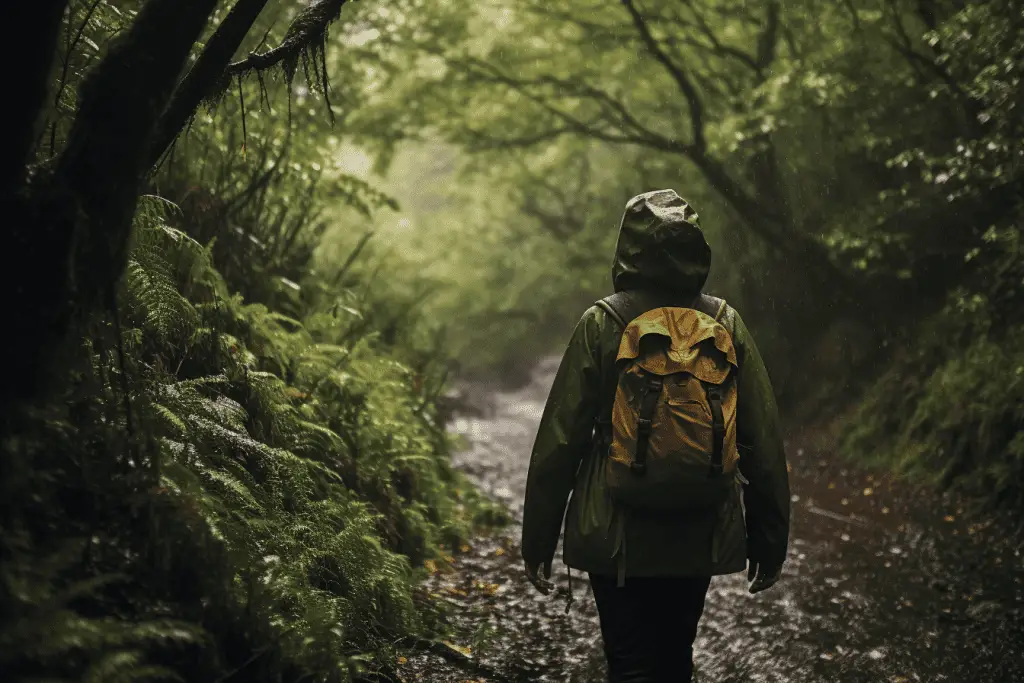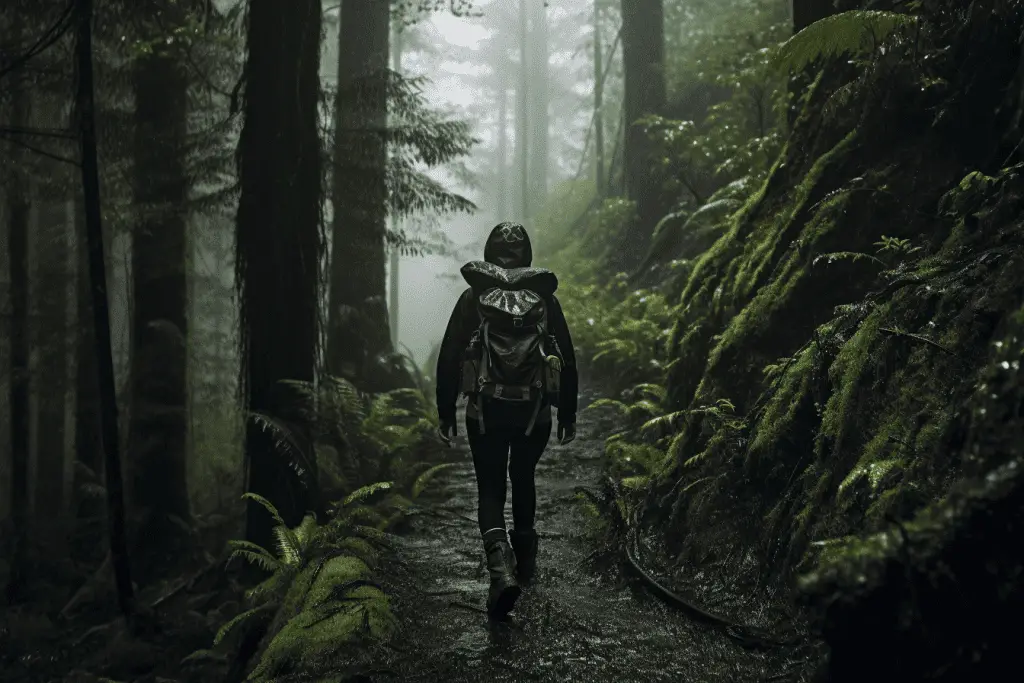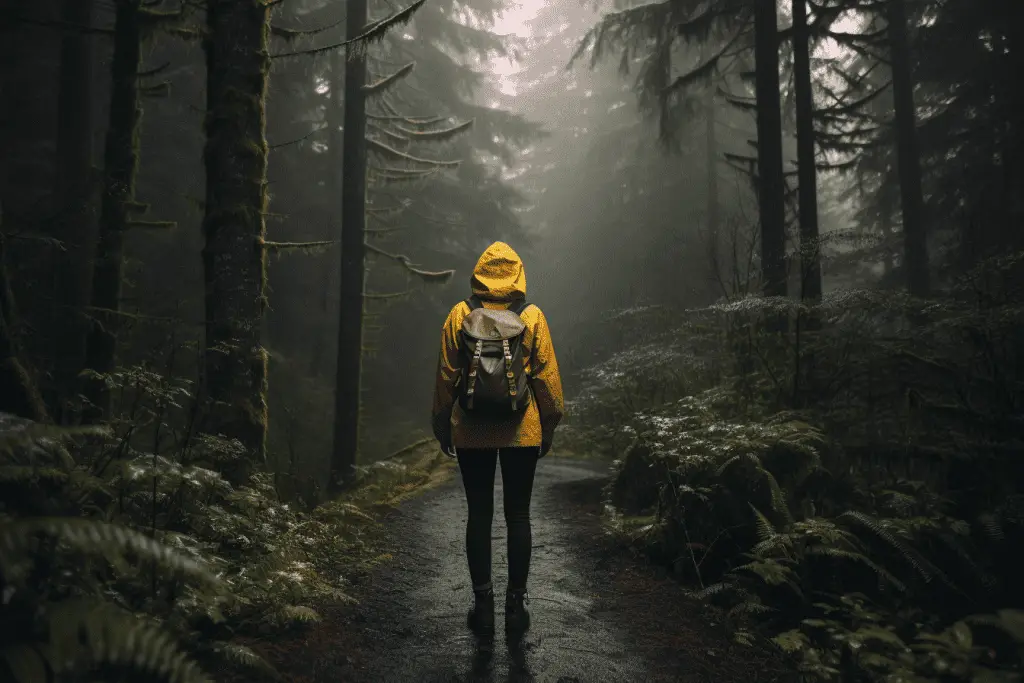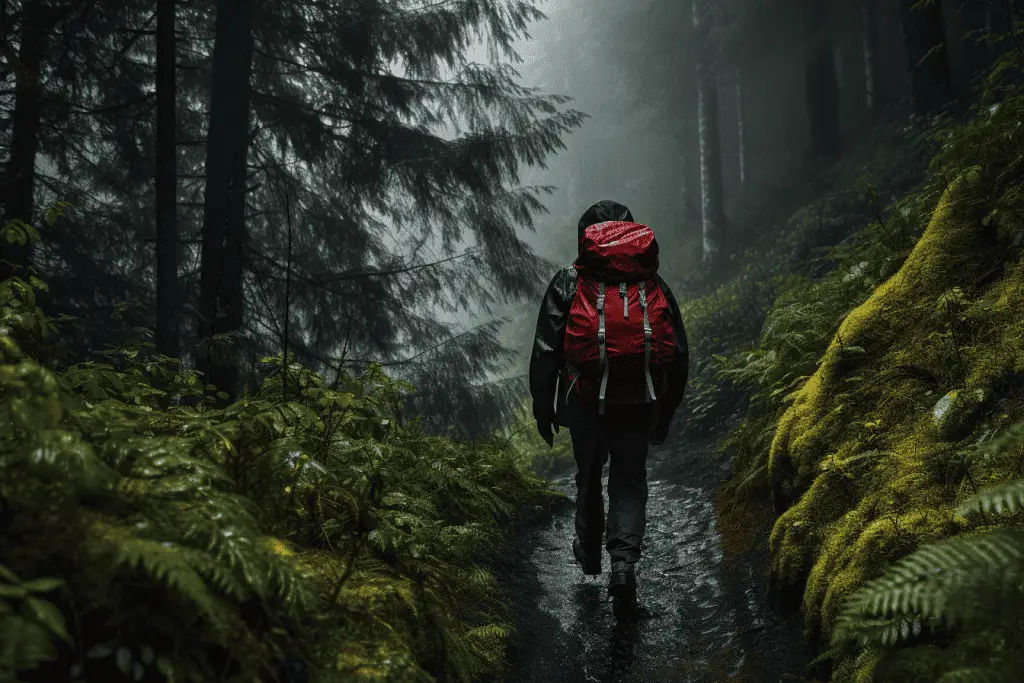You’re preparing for a hiking trip and the forecast hints at showers. You’re stuck in the classic dilemma – poncho vs rain jacket for hiking. It seems like a simple choice, but, as any seasoned hiker will tell you, the devil’s in the details. This age-old debate divides outdoor enthusiasts all over the world, but it’s not a matter of right or wrong, rather, it’s about what suits your needs and preferences best.
Think about it: ponchos, with their simple design and all-round coverage, versus rain jackets, tailored for mobility and offering a snug fit. Each brings unique advantages to the table, and understanding these can help you make an informed choice. After all, when you’re tackling the trail under a heavy downpour, you want to ensure you’ve made the best decision for your comfort and safety. So, let’s delve into the great poncho versus rain jacket debate, and help you make your choice!

Exploring the Essentials: What is a Hiking Poncho?
So, let’s kick off this discussion by introducing the first contender – the humble hiking poncho. When you imagine a poncho, you might visualize a simple, draped garment, much like a large blanket with a hole in the middle for your head. And you wouldn’t be entirely off the mark. But the hiking poncho is a little more refined than that. It’s designed specifically with the great outdoors in mind, typically made of waterproof or water-resistant materials, and sometimes even includes additional features like hood and snap closures.
But what makes a hiking poncho stand out? The coverage, my friend. A hiking poncho typically covers both you and your backpack. This large area of protection can be invaluable when the rain is coming down in sheets. Imagine not worrying about your gear getting wet, or fussing with an extra rain cover for your backpack. That’s the charm of a poncho.

Yet, simplicity can also be its downfall. Ponchos don’t offer the tailored fit that some hikers prefer. They’re a bit loose, a bit breezy, and, well, a bit shapeless. They can catch the wind easily, turning your hike into a wrestling match with your gear. But on the flip side, this roomy design can help keep you cool and offers excellent ventilation, a boon in humid or muggy conditions.
In a nutshell, the hiking poncho is all about trade-offs. It offers a great deal of coverage, simplicity, and ventilation, but compromises on fit and resistance to wind. If you value ease and coverage above all else, the poncho could be your go-to for your next hiking adventure.
The Basics of a Rain Jacket for Hiking
Now that we’ve got a handle on the poncho, it’s time to shift gears and talk about its worthy competitor: the rain jacket. If you picture a rain jacket, you likely imagine a snug, fitted garment with a zipper running down the front. It’s a pretty straightforward piece of gear, but don’t let that fool you. Rain jackets designed for hiking have several nuances to them, from their waterproof materials to their breathable design.
The most significant advantage of a rain jacket is its tailored fit and design. Unlike ponchos, rain jackets are designed to fit close to your body, providing a sleeker profile that’s less likely to catch the wind. This fit also helps to maintain your body temperature by reducing heat loss, a huge bonus in chillier conditions. Many hiking rain jackets come with a hood, adjustable cuffs, and sometimes even pit zips for added ventilation.

However, this tight fit can also be a downside. While rain jackets can keep you warmer, they might not offer as much ventilation as ponchos. And while the jacket itself may be waterproof, your backpack and gear might not be as protected. You may need to bring along an additional cover to protect your gear from getting drenched in the rain.
In essence, a rain jacket offers a blend of warmth, wind resistance, and a streamlined fit but may lack in ventilation and gear protection. If you’re someone who values a snug fit and weather resistance, a hiking rain jacket might be just the ticket for your outdoor adventures.
Unpacking the Features: Ponchos for Hiking
Alright, let’s dive a little deeper into what ponchos bring to the hiking table. At first glance, a poncho might seem like a simple, one-size-fits-all type of garment. But don’t underestimate it – there’s more to this piece of gear than meets the eye.
One key feature of many hiking ponchos is their multi-functionality. Due to their generous size and shape, some ponchos can double as a groundsheet or a makeshift shelter in a pinch. This can be a real game-changer in unexpected circumstances, like when you need to take a break from the trail or when you’re setting up camp and the ground is damp.

Many hiking ponchos also come equipped with adjustable hoods and drawstrings, allowing for a more secure fit and better protection against wind and rain. Some even have armholes or sleeves, bridging the gap between the loose comfort of a poncho and the snug fit of a jacket. And let’s not forget about the added bonus of ventilation. The looser fit of a poncho can help you avoid the sauna effect that can occur with more form-fitting rainwear.
Lastly, a feature often overlooked is that ponchos are usually quite easy to put on and take off. This can be incredibly convenient when the weather can’t make up its mind, and you’re constantly facing on-and-off showers. So, while it might appear basic, the hiking poncho packs in a surprising array of features designed with the hiker’s comfort and convenience in mind.
An In-Depth Look: Key Attributes of Rain Jackets
Now, let’s switch gears back to rain jackets and examine what makes them a favored choice for many hikers. While they may seem simple on the surface, rain jackets boast a number of features that make them an efficient piece of hiking gear.
First off, rain jackets typically employ advanced waterproofing technologies. Brands use a variety of methods, from durable water-repellent (DWR) coatings to breathable, waterproof fabrics like Gore-Tex. This means not only do they keep the rain out, but they also allow sweat to escape, preventing you from getting soaked from the inside.

In terms of design, rain jackets often come with a suite of adjustable elements. Think drawstring hoods, velcro cuffs, and waist cinches. These features help you tailor the fit of your jacket to your body, providing effective protection against wind and rain. Many rain jackets also incorporate pit zips or other venting options to improve breathability and prevent overheating.
Finally, rain jackets often score high on the durability scale. They’re designed to withstand not just rain, but also the wear and tear of hiking, from brambles and tree branches to the occasional tumble on rocky trails. Some even have reinforced areas, like shoulders and elbows, to provide extra resistance where it’s needed most. So while a rain jacket may seem like a simple piece of gear, it’s packed with features that work to keep you dry, comfortable, and protected in the great outdoors.
Decoding the Material: Understanding Waterproof Technology
Whether you’re choosing a poncho or a rain jacket, the material it’s made of and the waterproof technology it employs can make or break your hiking experience. So, let’s dive in and break down what you need to know about these all-important elements.
When we talk about waterproof materials, we often hear terms like ‘water-resistant,’ ‘water-repellent,’ and ‘waterproof,’ but what do they actually mean? Well, ‘water-resistant’ means the material can resist the penetration of water to some degree but not entirely. ‘Water-repellent’ materials, on the other hand, are designed to repel water more effectively but can still be permeated in heavier rain or over prolonged periods. ‘Waterproof’ is the term used for materials that are impervious to water, regardless of how long or heavy the downpour is.
Both ponchos and rain jackets employ a variety of waterproof technologies. You’ll find garments made from materials like PVC, which is fully waterproof but not very breathable, or coated nylon, which balances water resistance and breathability. High-end gear often utilizes advanced materials such as Gore-Tex or eVent, which offer top-notch waterproofing while still allowing sweat to evaporate.
But remember, it’s not just about the material itself. Features like taped seams, waterproof zippers, and storm flaps over zippers also contribute to a garment’s overall waterproofness. So when you’re choosing between a poncho or a rain jacket for your hiking trip, take a moment to understand the materials and waterproof technology in play. It could mean the difference between a comfortable hike and a soggy ordeal.
The Weight Factor: Ponchos vs. Rain Jackets
One aspect of hiking gear that often gets overlooked is weight. When you’re packing for a multi-day hike, every ounce counts, and this applies to your choice of rain protection too. Let’s compare ponchos and rain jackets in terms of weight.
Hiking Poncho Weights
Ponchos, in general, have a reputation for being quite lightweight. They’re usually made of a single piece of material, without much in the way of added features like pockets or zippers that can add weight. Plus, a poncho can often serve multiple purposes, potentially replacing a separate groundsheet or tarp in your backpack, which can help reduce your overall load.
Rain Jacket Weights
Rain jackets, on the other hand, can be a bit heavier. They often incorporate more complex construction, with multiple layers of material, zippers, pockets, and sometimes even added insulation. However, it’s worth noting that there are lightweight rain jackets available on the market. These are often made from high-tech materials that offer excellent protection from the elements without adding too much to your pack weight.
Making Your Choice
So, while ponchos tend to be lighter, don’t write off rain jackets entirely. If weight is a significant concern for you, it’s worth taking the time to explore lightweight rain jacket options. However, if you’re striving for the lightest possible pack and don’t mind the simpler design, a poncho might be your best bet.
Ultimately, the decision should be based not just on the weight of the garment itself, but also on its functionality and how it fits into your overall packing strategy. After all, what’s a few extra ounces if it means staying dry and comfortable on the trail?
| Ultralight | Standard | Heavy-Duty | |
| Rain Jacket | 6-12 ounces | 16-28 ounces | >30 ounces |
| Hiking Poncho | 7-9 ounces | 9-16 ounces | 18-25 ounces |
This table structure outlines the average weight ranges for both ultralight, standard, and heavy-duty versions of rain jackets and hiking ponchos. As always, weights may vary based on factors like brand, materials, size, and additional features. Always check the specific product details for the most accurate information.
Hiking Poncho vs Rain Jacket: Which One Lasts Longer?
Let’s get down to one of the key elements that can significantly influence your decision between a poncho and a rain jacket: durability. When you’re out on the trail, exposed to the elements, and potentially brushing against rough vegetation or rocks, you need your gear to stand up to the test. But do ponchos and rain jackets hold up equally well? Let’s take a look.
Durability of Hiking Ponchos
Ponchos, due to their simplicity and lesser number of parts, are generally quite durable. They’re less likely to suffer from broken zippers or torn seams, simply because they don’t usually have any! Plus, many ponchos are made of robust materials like PVC or ripstop nylon. But it’s worth noting that their larger surface area could potentially make them more prone to snagging or tearing.
Durability of Rain Jackets
Rain jackets, on the other hand, are often built to last. They’re designed with hiking in mind, with reinforcement in high-wear areas and sturdy construction. The materials used are often very durable, resisting tears and abrasions. However, their multiple components – like zippers and drawstrings – could potentially fail over time, especially if not properly cared for.
Packing and Unpacking
One more aspect to consider is how the garment handles repeated packing and unpacking. Both ponchos and rain jackets can be susceptible to wear and tear from constant folding, stuffing, and unpacking, so consider the quality and resilience of the material.
Longevity Moving Forward
In conclusion, both ponchos and rain jackets can be quite durable, but the devil is in the details. Consider your hiking environment, the quality of the garment’s construction and material, and how well you maintain your gear. All these factors will contribute to the longevity of your rain protection on the trail.
Ease of Movement: Ponchos and Rain Jackets Compared
When you’re hiking, freedom of movement is paramount. The last thing you want is your gear inhibiting your stride or making you uncomfortable. So, how do ponchos and rain jackets measure up in terms of ease of movement? Let’s explore.
Ease of Movement in Ponchos
First up, ponchos. One might argue that ponchos offer excellent freedom of movement. With their loose, drape-like design, ponchos are hardly restrictive. There are no tight cuffs to restrict your arm movements or tight hems to hinder your stride. But while ponchos allow for a broad range of motion, their very looseness can sometimes be a disadvantage. In high winds, a poncho can turn into a billowing sail, making it difficult to move efficiently or comfortably.
Ease of Movement in Rain Jackets
Now, let’s talk rain jackets. These are designed with a more body-contouring fit. The snug design, in general, moves with your body, allowing for a wide range of movements. Many rain jackets designed for hiking also incorporate features such as articulated elbows or gusseted underarms, which are designed to enhance mobility. However, a poorly fitted rain jacket can restrict movement, especially if the sleeves are too tight or the hem is too narrow.
The Bottom Line
Here’s the bottom line: both ponchos and rain jackets have their pros and cons when it comes to ease of movement. Ponchos offer non-restrictive, free-form comfort but can be unwieldy in windy conditions. Rain jackets provide a fit that moves with you but can be restrictive if not well-fitted. As always, the best choice depends on your personal preferences, your hiking conditions, and the specific design of the poncho or jacket.
Adaptability in Varying Weather Conditions
When it comes to hiking, the weather is a wild card. One moment it might be sunny and clear, and the next, you could be in the middle of a downpour. This is where the adaptability of your rain protection gear really comes into play. Let’s explore how ponchos and rain jackets fare in various weather conditions.
The Adaptability of Hiking Ponchos
Starting with ponchos, they excel in warmer, wet climates. Due to their loose design, they allow for ample ventilation, preventing you from overheating during warm, rainy weather. Additionally, many ponchos can be adjusted to cover more or less of your body as needed. They’re also great in sudden downpours, as they’re often quicker and easier to throw on than a jacket. However, in high winds, a poncho can become somewhat unmanageable due to its loose fit.
The Adaptability of Rain Jackets
Now, let’s look at rain jackets. They often perform better in cooler, wet climates because of their close-fitting design, which provides a natural insulating layer of warmth. Many also have adjustable cuffs, hems, and hoods, allowing you to seal out drafts and rain when needed. Unlike ponchos, rain jackets tend to handle windy conditions well, as they’re less likely to catch the wind and billow out. But in hot, humid conditions, a rain jacket might not provide as much ventilation as a poncho, leading to potential discomfort from overheating.
In terms of adaptability, rain jackets often come with more features like pit zips and mesh-lined pockets that can increase breathability in warmer conditions. Some high-end models also incorporate layers and materials that enhance both waterproofing and breathability.
Final Thoughts on Poncho vs Rain Jacket Adaptability
In conclusion, both ponchos and rain jackets have their own strengths and weaknesses when it comes to adapting to varying weather conditions. Consider the typical climate and weather patterns of your preferred hiking locations when choosing between these two options. Always remember that no gear can be perfect for every situation, so choose based on what suits your needs best.
Size and Packing: What’s More Convenient for Backpackers?
Hiking, especially backpacking, demands smart packing. The size and packability of your gear are critical factors to consider. So, let’s examine ponchos and rain jackets from this perspective.
Poncho Packability
Ponchos are renowned for their simplicity and compactness. Often, they can be folded or rolled up into a very small package, making them a backpacker’s dream. Many even come with their own pouch or pocket for convenient packing. Another plus point for ponchos is their versatility. A poncho can often serve as a makeshift tarp or groundsheet, providing more utility for the space it occupies in your pack.
Rain Jacket Packability
Rain jackets, on the other hand, don’t usually pack down as small as ponchos due to their more complex construction and heavier materials. However, advancements in fabric technology have led to the creation of compact, lightweight rain jackets that can fit neatly in your pack without taking up too much space. Like ponchos, many rain jackets also come with a stuff sack or can be packed into one of their own pockets for convenience.
In terms of size, rain jackets generally take up more room because of their structure, which includes elements like zippers, pockets, and sometimes a lining. On the flip side, this structure often allows for a more comfortable and secure fit than a poncho, which might be a fair trade-off for some hikers.
Which Packs Down Better?
In a nutshell, when it comes to size and packability, ponchos generally have the upper hand due to their simplicity and compactness. However, recent advancements in outdoor gear technology have brought some rain jackets pretty close in the competition. So, consider your packing priorities, and decide whether you value space-saving more, or a structured, secure fit when bracing the elements. As always, it’s about finding the right balance that suits your hiking style and needs.
Cost Considerations: Ponchos and Rain Jackets Price Comparison
When choosing your hiking gear, price is undoubtedly a crucial factor to consider. After all, we all want to get the most bang for our buck! So, how do ponchos and rain jackets compare in terms of cost? Let’s dive in.
Hiking Poncho Prices
Ponchos are generally the more cost-effective option of the two. Basic ponchos can be found at very low prices, making them an accessible choice for hikers on a budget. Of course, the price can go up depending on the material and features. High-end ponchos, often made of durable, breathable materials with added features like adjustable hoods or snap closures, will cost more. However, even the most expensive ponchos usually come in under the price of high-end rain jackets.
How Much Do Hiking Ponchos Cost?
Hiking ponchos can range widely in price depending on factors like material, brand, and additional features. On the lower end, a basic, no-frills hiking poncho might cost as little as $10 to $20. These are usually made from lightweight, less durable materials and offer basic protection against rain. Mid-range ponchos, often made of more durable materials and offering features like reinforced grommets, taped seams, or storage pouches, usually run from $30 to $60. High-end hiking ponchos, designed with premium waterproof materials, increased durability, and features for enhanced comfort and versatility, can go upwards of $100. Always remember that prices can vary depending on where and when you buy, so it’s a good idea to shop around and compare prices before making a purchase.
| Poncho Type | Price Range |
|---|---|
| Basic | $10 – $20 |
| Mid-Range | $30 – $60 |
| High-End | $100 and up |
Rain Jacket Prices
When it comes to rain jackets, you’re generally looking at a higher price point. The complexity of their design, the materials used, and the technologies incorporated all contribute to the cost. Basic rain jackets can still be affordable, but high-end jackets, particularly those with advanced waterproofing technologies or brand-name materials like Gore-Tex, can reach into the hundreds of dollars.
How Much Do Hiking Rain Jackets Cost?
The cost of hiking rain jackets varies considerably based on factors like brand, materials, technology, and added features. Basic rain jackets can start from around $50 to $100. These jackets typically offer basic waterproofing and may have limited breathability. Mid-range jackets, which often come with better materials and features like ventilation zips, adjustable hoods, or taped seams, usually range from $100 to $250. For high-end rain jackets, which are often constructed with top-notch materials and incorporate advanced waterproofing technologies like Gore-Tex, you can expect to pay anywhere from $250 to over $500. As always, prices can fluctuate based on where and when you buy, and it’s recommended to compare prices and check reviews before making a final decision.
| Rain Jacket Type | Price Range |
|---|---|
| Basic | $50 – $100 |
| Mid-Range | $100 – $250 |
| High-End | $250 – $500 and up |
Other Considerations
That being said, it’s essential to consider the longevity and versatility of the product. A durable, high-quality rain jacket might have a higher upfront cost, but if it lasts for many years and provides reliable protection in various weather conditions, it could be a worthwhile investment. Conversely, if you only need occasional rain protection and are okay with a less structured fit, a poncho could be the more economical choice.
In conclusion, while ponchos generally offer a more budget-friendly option, rain jackets may provide better value in terms of durability, comfort, and advanced features. As with any purchase, it’s important to consider not just the price but the overall value the product provides. Prioritize your needs, consider your budget, and choose the gear that best suits your hiking style and requirements.
Layering Strategy: Wearing Ponchos and Rain Jackets Over Other Clothes
Layering your clothing is a smart strategy for hiking, as it allows you to adapt to changing weather conditions and maintain a comfortable body temperature. Now, how do ponchos and rain jackets fit into this strategy? Let’s discuss.
Layering Your Poncho
Ponchos, thanks to their loose and airy design, can easily be thrown over any combination of clothing. Whether you’re wearing a t-shirt or a bulky fleece jacket, a poncho can easily cover everything, providing you with a flexible layer of waterproof protection. However, because of their open design, ponchos might not retain heat as effectively as a rain jacket. So if you’re hiking in colder weather, you might need to wear more insulating layers underneath.
Layering Your Rain Jacket
On the other hand, rain jackets provide a closer fit, which can be a good or a bad thing depending on your layering needs. On the plus side, a rain jacket can create an effective barrier against wind, helping to retain heat more efficiently than a poncho. This makes it a great outer layer in colder, windier conditions. However, if you’re wearing bulky layers underneath, you’ll need to ensure your rain jacket is roomy enough to accommodate them without restricting your movement.
High-end rain jackets often have features like pit zips that can be opened for ventilation if you start to overheat, making them more versatile for varying activity levels and temperatures. However, regardless of whether you choose a poncho or a rain jacket, always remember the principle of layering: start with a moisture-wicking base layer, add an insulating middle layer for warmth, and top it off with a waterproof or water-resistant outer layer to protect against the elements.
Which Layers Better?
To sum up, both ponchos and rain jackets have their place in a smart layering strategy for hiking. Ponchos offer more flexibility and can be quickly thrown over any outfit, while rain jackets provide better heat retention and wind protection. Consider the climate, your activity level, and personal comfort when deciding which option fits best into your layering plan.
Making the Decision: Factors to Consider When Choosing Between a Poncho and a Rain Jacket
Here are some key factors you should consider when deciding between a poncho and a rain jacket for your hiking needs:
- Weather Conditions: Consider the typical weather conditions you’ll be hiking in. If you expect light to moderate rain and want something quick and easy to throw on, a poncho might be the way to go. For heavier rain, wind, or colder conditions, a rain jacket will generally provide better protection.
- Breathability and Comfort: If you’re hiking in warmer climates or exerting yourself a lot, breathability will be a key factor. Ponchos, with their loose fit, can often offer better ventilation. Rain jackets can also be breathable, particularly higher-end models with features like venting zips.
- Durability: If you’re a frequent hiker or plan to tackle rougher terrains, durability will be an essential factor. Rain jackets generally tend to be more durable than ponchos.
- Weight and Packability: Consider the weight and size of the gear, especially if you’re backpacking. Ponchos are generally lighter and pack down smaller, which could be a plus for those needing to save on space and weight.
- Cost: Ponchos are generally less expensive than rain jackets, but remember to consider factors like durability and features that could make a more expensive rain jacket a better long-term investment.
- Versatility: A poncho can often double up as a groundsheet or tarp, while a rain jacket might provide a more comfortable fit and better protection in diverse conditions.
- Layering Strategy: If you plan to wear heavy layers underneath, a poncho’s loose fit could be advantageous. A rain jacket might be a better choice for colder, windier conditions due to its close fit and better heat retention.
- Style and Preference: Lastly, consider your personal style and comfort preferences. Some people prefer the fit and feel of a rain jacket, while others prefer the easy-on, easy-off nature of a poncho.
Remember, the right choice depends on your specific needs, preferences, and the conditions you’ll be hiking in. It’s always a good idea to try on different options, read reviews, and consider what features matter most to you before making a decision.
Conclusion: The Verdict – Poncho or Rain Jacket for Hiking?
The debate of poncho vs rain jacket for hiking in the rain presents a compelling case for both sides, each having their own set of advantages and considerations. The truth is, there’s no one-size-fits-all answer to this question – the right choice will vary from hiker to hiker based on individual needs, preferences, and the specific conditions they’ll be hiking in.
Ponchos shine in their simplicity, lightweight design, breathability, and versatility, making them a great option for lighter rains and warmer climates, or for those who need something to quickly throw on over their existing gear. Rain jackets, on the other hand, excel in providing superior protection against wind and heavy rain, offer a more precise fit, and often feature advanced technology that enhances durability and breathability. For more extreme weather conditions or for those who plan on hiking frequently, a rain jacket could be a worthy investment. In the end, it’s about weighing up the features, costs, and benefits of each option against your personal hiking needs and choosing the one that ticks the most boxes for you. Happy hiking!
